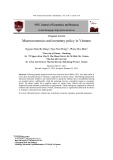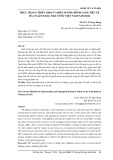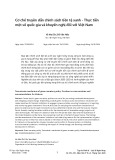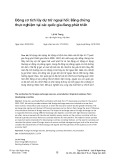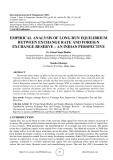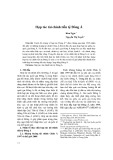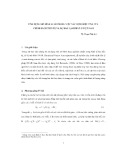
* Corresponding author
E-mail address: taiketoanquocte@gmail.com (D.T. Do)
© 2020 by the authors; licensee Growing Science.
doi: 10.5267/j.uscm.2020.2.004
Uncertain Supply Chain Management 8 (2020) 589–598
Contents lists available at GrowingScience
Uncertain Supply Chain Management
home
p
a
g
e: www.Growin
g
Science.com/usc
m
Impact of corporate social responsibility toward employees on business performance: The case
of Vietnam
Thi Minh Phuong Nguyena, Quang Bach Trana, Duc Tai Dob* and Dieu Linh Trana
aVinh University, Vietnam
bUniversity of Labour and Social Affairs, Vietnam
C H R O N I C L E A B S T R A C T
Article history:
Received November 29, 2019
Received in revised format
January 31, 2020
Accepted February 17 2020
Available online
February 17 2020
The study aims to test the impact of social responsibility toward employees on the business
performance. The sample selected includes 667 employees in the enterprises. The research
results show that the social responsibility factor had direct and indirect impacts on the business
performance of enterprises through two intermediaries: cohesion and opportunistic workers’
behavior. Based on the research results, we propose a number of recommendations to increase
the efficiency of business operations of the enterprises through improving corporate social
responsibility toward employees in countries with emerging economies, including Vietnam.
.2020 b
y
the authors; license Growin
g
Science, Canada©
Keywords:
Corporate social
responsibility
Engagement
Opportunistic behavior
Business performance
1. Introduction
Corporate social responsibility toward employees is attached to the employee's work-related requirements and the
organization's ability to meet those requirements. Employees will most likely feel satisfied and motivated to work if they
feel that their expectations and organizational commitment to workers are met. According to Hopkins (2003), one of the
most obvious intangible benefits of engaging in corporate social responsibility is increased employee loyalty and
satisfaction. Mittal et al. (2008) suggest that corporate social responsibility has a positive impact on employee productivity.
Employees feel more satisfied with the organization's value values. According to Jenkins (2006), Zairi and Peters (2002),
research on corporate social responsibility will often be related to long-term benefits, not short-term benefits. Corporate
social responsibility can also attract better employees (Turban & Greening, 1997). Backhaus et al. (2002) demonstrate that
corporate social responsibility increases the attractiveness of a company to potential employees and the most influential
areas of corporate social responsibility include environmental issues, community relations and diverse policies. Buzzell and
Gale (1987) argue that performance is the degree to which an enterprise's business goals are achieved, related to revenue
growth, sales, profits, growth, market share, as well as the level of strategic goal completion. In this same view, Keegan et
al. (1989) put forward a matrix of measurement of business results by classifying measurement results based on cost and
non-cost. Improving business performance is considered as the key goal for enterprises operating in the market. Katou and
Budhwar (2010) point out that performance is positively correlated with the reward direction, compensation based on
performance, professional training and development for employees, assessing performance results fairly, and motivating
employees to work. According to research by Koh and Boo (2001), corporate social responsibility performance has positive
relationship with employee satisfaction and at the same time help employees engaged and motivated to stay longer with

590
company. Bakiev (2013) argues that high performance through intermediaries such as relationships between employee trust,
engagement, and organizational performance awareness have a positive impact on business performance. After studying
the relationship between remuneration, performance evaluation, promotion practices and organizational performance, the
results of Shahzad et al. (2008) showed that these factors are positively correlated with each other. Up to now, in many of
their research projects, many authors have mentioned the relationship between corporate social responsibility toward
employees on business performance. Most studies favor the thesis that corporate social responsibility has a positive effect
on business performance. Siddiq and Javed (2014), and Adamu Yusoff (2016) suggested that social responsibility of
enterprises have a positive and strong impact on business performance. Meanwhile, Khan et al. (2016) also mentioned
corporate social responsibility as a good measure to increase the efficiency of business operations of enterprises. Kiran et
al. (2015) demonstrate that social responsibility has a positive impact on net profit and net profit margin, total assets of the
company but has no significant impact on the profitability of the business. However, in the studies of Rahman et al. (2014),
Ofori et al. (2014), there is no relationship between corporate social responsibility and business performance.
In fact, the issue of social responsibility toward employees has been paid much attention and awareness by many businesses
through many activities to improve the life quality of employees and their families. Enterprises which implement social
responsibility have shown that their benefits not only do not diminish, but increase significantly. Workers have a good spirit,
a positive working attitude, cohesion and dedication in their work are promoted. However, most Vietnamese enterprises
with small and medium scale still have short-term thinking, fragmented and small working ways. With the aim of getting
immediate profits, these businesses have not really taken effective measures to care for employees or ignore the interests of
employees. Many businesses are tending to avoid the implementation of social responsibility for employees, which seriously
impact on individual benefits of workers, working attitudes, efforts at work as well as labor productivity. As a consequence,
this issue reduces the momentum of growth and long-term development of the business.
In this study, we mentioned the impact of corporate social responsibility toward employees on business performance in
Vietnamese enterprises. At the same time, this study clarifies the intermediary role of engagement and opportunistic
behavior factors in the direct and indirect impact relationships of social responsibility and business performance of
enterprises.
2. Theoretical framework and Hypotheses
2.1. Corporate social responsibility toward employees and business performance
Maignan and Ferrell (2004) argue that a business is socially responsible for its decisions and activities to create and balance
the various interests of individuals and organizations involved. Corporate social responsibility toward employees is tied to
the employee's work-related requirements and the organization's ability to meet those requirements. Employees will most
likely feel satisfied and motivated to work if they feel their expectations and organizational commitment to workers are met
at a reasonable level. In addition, Carroll (1979) defines that corporate social responsibility includes society’s expectations
of the economy, law, ethics and philanthropy of organizations at a given time. Brammer et al. (2007) proposed components
of corporate social responsibility including: social responsibility toward society, social responsibility toward the natural
environment, social responsibility toward customers, social responsibility toward other external parties, social responsibility
toward the law, social responsibility for fairness in policies, social responsibility for training staff. The research results show
a correlation between the components of corporate social responsibility and employee engagement with the organization.
The following component is the external social responsibility of the corporations and the final part is the issue of training
staff. Imran Ali et al. (2010) considered the impact of corporate social responsibility on employee engagement with the
organization, as well as how corporate social responsibility and employee engagement affect organizational performance.
The study demonstrates that corporate social responsibility including activities for the benefit of employees and their
families increases employee engagement with the organization. The more businesses contribute to society, the more they
attract potential employees and the more they improve their current level of engagement. Company’s positive actions
motivate employees to introduce the company to others, making them feel more proud of their company and thus improving
their productivity. Moreover, social responsibility also creates credibility for the business with customers, investors,
suppliers and governments, followed by the positive effects on decision making that are beneficial to the business. Social
responsibility also brings a competitive advantage, thereby positively affecting the effectiveness of the organization. In
addition, organizations can enhance employee engagement by promoting socially beneficial activities. All these activities
will affect employee engagement with the organization, thereby, affecting employee productivity and thereby increasing
the efficiency of the organization. Neely et al. (1995) suggest that business performance is a set of criteria to quantify the
efficiency and effectiveness of all aspects of business activities. It is tested by 03 levels: individual, business goals and the
relationship between those evaluation criteria and the operating environment (culture, customer satisfaction, development
strategy, etc.). Maisel (2001) assesses business performance of enterprises as a system that helps businesses build plans,
measure and control the results of sales, marketing, information technology and decision making. business planning and
other activities of the enterprise to set goals and create value for people with related interests. According to Kaplan and
Norton (1993), the effectiveness of a business is determined from four basic component groups, including finance,
customers, internal processes and development learning. It builds the basis for turning business strategy content into
execution terms. In addition to the two direct impact factors mentioned in the research content are corporate social
responsibility toward employees and business performance. The study also addresses intermediary factors including the

T. M. P. Nguyen et al. /Uncertain Supply Chain Management 8 (2020)
591
cohesion and opportunistic behavior of employees in the organization.
According to Meyer and Allen (1997), organizational attachment is a psychological state that indicates the employee's
relationship with the organization, demonstrating an inextricable commitment to the organization and a desire to contribute
to the accomplishment of the organization's goals. Si and Li (2012) think that organizational engagement is mediated in the
relationship between human resource management practices and employee behavior. Cohesion with the organization has
the important role in regulating and creating relationships within the organization. At the same time, it creates more support
in the work process of workers from colleagues, managers and organizations. According to O’Reilly and Chatman (1986),
cohesion with an organization is defined as the psychological state of a member of an organization, reflecting the extent to
which individuals absorb or accept the characteristics of the organization. Mowday et al. (1982) refer to organizational
commitment as a relative strength of the uniformity of staff and organization and the active involvement of employees in
an organization. Meanwhile, Charles and Jennifer (1986) have shown that engagement is the attitude of workers. The authors
found that access to engagement in the organization was divided into three factors: compliance, identification, and
acquisition. In particular, compliance occurs when attitudes and behaviors are accepted not by shared beliefs but simply by
achieving a specific reward. Identity occurs when an individual feels proud to be a member of an organization, respecting
the organization's values and achievements without considering it as a personal achievement. Meyer and Allen (1991)
proposed three components of engagement: (1) Affective cohesion (Affective): is the emotion of attachment, unity and
commitment in the organization. In other words, it is desirable to be an organization member. This is the highest degree of
personal attachment to the organization when the individual feels an integral part of the organization and the goals and
interests of the organization are placed above the individual goals. (2) Cohesion to maintain (Continuance): is the
willingness to work hard, employees realize that they will lose costs when leaving the organization. Therefore, once getting
higher benefits from other corporations, workers will leave the organization. (3) Ethical commitment (Normative): as an
obligation, employees feel obligated to continue their work. This is the most lax level of cohesion, when the obligations are
over, workers will leave the organization. Knowing the above components, businesses should try to create emotional
cohesion in their employees, thus ensuring long-term employee retention. Mathieu and Zajac (1990) suggest that the
premise for employees to engage with the organization is often classified into personal characteristics, work, work
experience and organizational characteristics. Personal characteristics refer to gender, age, education, marital status, job
level, and seniority. Job characteristics focus on diversity in job skills, autonomy in tasks, job challenges and scope of work.
The characteristics of an organization include its organizational policies, support, information and exchange and
recognition. Opportunistic behavior is one that seeks personal gain through fraud (Williamson 1975), which essentially
breaks commitments, violates obligations and responsibilities that must be fulfilled (Morgan & Hunt, 1994). In
organizations, the types of behaviors that determine workers' performance include those that are directly related to
productivity, absenteeism, and manpower change. The attitude of employees is related to the level of job satisfaction.
Satisfaction is related to labor productivity, inversely proportional to the absence of workers. Creating and improving job
satisfaction is also the responsibility of managers to employees. Employees' behaviors and attitudes are related to the jobs
they undertake.
Opportunistic behavior is considered a form of negative behavior of employees in the organization, dominated and decided
by the awareness, attitudes and capabilities of the employees themselves. The person as a member of an organization is
influenced by organizational factors such as culture, leadership, power, organizational structure, and groups of organizations
in which the employee is a team member.
2.2. Hypotheses
Corporate social responsibility toward employees and employee engagement
The study of Nejati and Ghasemi (2013) based on Turker (2008) confirms that corporate social responsibility toward
employees has a positive impact on employee engagement with the organization. Research results of Maignan et al. (1999)
indicate that social responsibility plays an important role in improving employee engagement. Turker (2008) in his study
demonstrated that corporate social responsibility for employees has a great influence on employee engagement. In general,
previous studies on the impact of corporate social responsibility toward employees on employee engagement with the
organization can be classified into two categories. The first type, the authors analyze how corporate social performance
affects potential employees (Albinger and Freeman, 2000; Backhaus et al., 2002; Turban and Greening, 1997, etc.). These
studies support the notion that corporate social responsibility toward employees creates the company's reputation and
promotes its attractiveness. Second, the authors focus on the impact of the organization's social activities on current
employees (Peterson, 2004; Rupp et al., 2007; Wood and Jones, 1995,etc.). Riordan et al. (1997) argued that corporate
social responsibility toward employees affects employees' attitudes, attitudes, behaviors and cohesion. Brammer et al.
(2007) studied and provided results of the inpact of social responsibility activities on organizational cohesion. Hence, most
of the studies agreed and pointed out the direct and positive impact of corporate social responsibility toward employees on
employee engagement in the organization. In the context of Vietnamese businesses, in order to test this relationship more
accurately, we hypothesized:
H1: Corporate social responsibility toward employees has a positive impact on employee engagement at Vietnamese
businesses.

592
Corporate social responsibility toward employees and opportunistic behavior
Gond et al. (2010) clarified the impact of the implementation of social responsibility toward employees' behaviors and
attitudes. Viswesvaran et al. (1998) analyze the association between corporate social responsibility toward employees and
employee’s opposing behavior. In the organization, there are always fraudulent acts, as well as taking advantage of
important relationships and important positions to benefit themselves. This seriously influences the management activities
as well as overall business performance. Fulfilling the corporate social responsibility toward employees has an effect on the
employees' positive behaviors in building positive relationships with colleagues, limiting negative behaviors and attitudes
in work. In the context of Vietnamese businesses, how does the corporate social responsibility issue toward employees
affect the opportunistic behavior of individuals in the enterprise? Accordingly, the following hypothesis is established in
this study:
H2: Corporate social responsibility toward employees has a negative impact on opportunity behavior in Vietnamese
businesses.
Engagement and opportunistic behavior of employees
In Theoretical Framework for Relationship Marketing, Morgan and Hunt (1994) have shown that there is a negative
relationship between opportunistic behavior and trust, which is the premise of the partner's commitment to a long-term
relationship. From an individual level in the enterprise, the research of Ritzer and Trice (1969) proved a positive relationship
between employee engagement and compensation policy. Improving employee engagement with the organization also
means the process of creating a stable mentality, long-term commitment and limiting negative factors, individual
opportunity behaviors in the organization. In order to clarify the relationship between the impact of corporate engagement
on the opportunistic behaviors of workers, the hypothesis is formulated:
H3: Employee engagement has a negative impact on the opportunistic behavior of workers in Vietnamese businesses.
Corporate social responsibility toward employees and business performance
Research by Thorne et al. (1993) has demonstrated that, if an enterprise does not fulfill its social responsibility, its
performance will be significantly reduced. Corporation’s social responsibility practices increase the willingness of existing
employees to improve financial results (Davis, 1973; McGuire et al., 1988). Implementation of social responsibility will
have a positive impact on the willingness of workers to participate in production and business activities, increasing
productivity and business efficiency for businesses.
In addition, many other studies also show similar results when evaluating corporate social responsibility toward employees
has a positive effect on business performance like Siddiq and Javed. (2014), Babola (2012), Khan et al (2016), Akanbi and
Ofoegbu (2012), Ahamed et al (2014), Yusoff and Adamu (2016). In order to test the impact of corporate social
responsibility towards employees on business performance, in the context of Vietnamese businesses, this study establishes
the following hypothesis:
H4: Corporate social responsibility toward employees has a positive impact on the business performance of Vietnamese
businesses.
Employee engagement and business performance
A number of studies by the authors pointed out that employee engagement impacts organizational processes and
performance (Mowday et al., 1982; Allen & Meyer, 1990; Shaw et al., 2003). Imran Ali et al. (2010) demonstrated that
employee engagement has a positive impact on organizational performance. In addition, studies of Bakiev (2013) and
Mansour et al. (2014) also show a positive relationship between employee engagement and business performance of
enterprises. Employee engagement is an important factor that contributes to the long-term success of the organization. To
increase business efficiency, Vietnamese businesses always focus on the cohesion, sustainable relationship between
colleagues and the management levels in the business. To test the relationship between these two factors, we suggest the
following hypothesis:
H5: The employees engagement has a positive impact on the business performance of Vietnamese businesses.
Opportunistic behavior and business performance
Studies have shown an indirect effect of opportunistic behavior on firm's business performance. According to Katsikeas et
al. (2009), there is a negative impact relationship of opportunistic behavior on trust, thereby affecting businesses
performance. Opportunistic behavior often stems from the demand and interests of individuals. In this relationship, the need
determines the benefits. Therefore, it is the basis of benefits, and the benefits are the opposite, derived from the demand,
based on the demand, which is the expression of the demand. However, if the business performance of the enterprise is
heavily influenced by personal interests, it will have a negative effect. Hence, in the context of Vietnamese enterprises,
whether there is a direct impact relationship between the opportunistic behavior of employees on the business performance
or not. This is the gap the study wants to make clear. The aim of the study is to clarify this research gap. Therefore, this

T. M. P. Nguyen et al. /Uncertain Supply Chain Management
8 (2020)
593
study establishes the following hypothesis:
H
6
: Opportunistic behavior has a negative impact on the business performance of Vietnamese businesses.
Fig. 1. Research model
3. Research methodology
3.1. Measurement Scales
Based on the theoretical overview and related research works, the paper proposes a research model with independent and
intermediate variables including: corporate social responsibility toward employees, engagement, opportunistic behavior and
the target variable that is business performance. The scale used in the research is a Likert scale with 5 levels (Strongly agree;
Agree; Normal; Disagree; Strongly disagree). The indicators measuring the applied variables are adjusted in accordance
with the characteristics of the sample from the previous studies. “Social responsibility” variable which uses scales by
Hopkins (2003) and Clarkson (1995) includes 5 observations. “Engagement” using Meyer's et al. (1993) consists of 5
observations. “Opportunity behavior” using a scale of Katsikeas et al (2009) including 5 observations. Business performance
using a Huselid scale (1995) consists of 6 observations.
Table 1
List of variables and indicators
Variable Code Indicator Sources
Corporate social
responsibility
toward employees
TNCX1 Encouraging workers to develop skills and long-term careers through assessment
and training
Modified application of the
scale of Hopkins (2003) and
Clarkson (1995) TNCX2 Anti-discrimination in recruitment, trainin
g
, promotions, salaries and bonuses
TNCX3 Creating a safe working environment and health care for employees (preventing
labor accidents, clean toilets, insurance, etc.)
TNCX4 Salary of enterprises compared to the average salary of the economic sector in
which businesses participate
TNCX5 Interest in spiritual livin
g
conditions for emplo
y
ees (sports, arts, tourism)
Engagement GK1 This company has an importan significance for me Modified application of the
scale of Meyer et al. (1993) GK2 I am proud to tell m
y
friends about m
y
workplace
GK3 I feel the obstacles of the business as my obstacles
GK4 I'm
g
lad to choose to work for this business
GK5 For me, this is a great place to wor
k
Opportunistic
behavior
CH1 In my company, managers often pursue their own interests in the working
p
rocess.
Modified application of the
scale of Katsikeas et al.
(2009) CH2 My relationship with colleagues is always dominated by
p
rivate interests.
CH3 There are always personal opportunities behaviors in the working process within
the compan
y
.
CH4 I always had high expectations for job advancemen
t
.
CH5 The results of my work are always heavily influenced by personal goals inside
and outside of the job.
Business
performance
HQ1 Recognizing that the quality of products and services of the company is
g
uaranteed.
Modified application of the
scale of Huselid (1995)
HQ2 Reco
g
nizin
g
tha
t
that the compan
y
has developed new products and services.
HQ3 Recognizing tha
t
the number of business products of the company has increased.
HQ4 Noticing the positive feedback from customers.
HQ5 Reco
g
nizin
g
tha
t
sales of enterprises has increased.
HQ6 Recognizing tha
t
p
rofitability of enterprises has increased.
H3 (-)
Opportunistic
behavior
Social
responsibility
Engagement
Business
performance
H5 (+)
H1 (+)
H6 (-)
H2 (-)
H4 (+)



